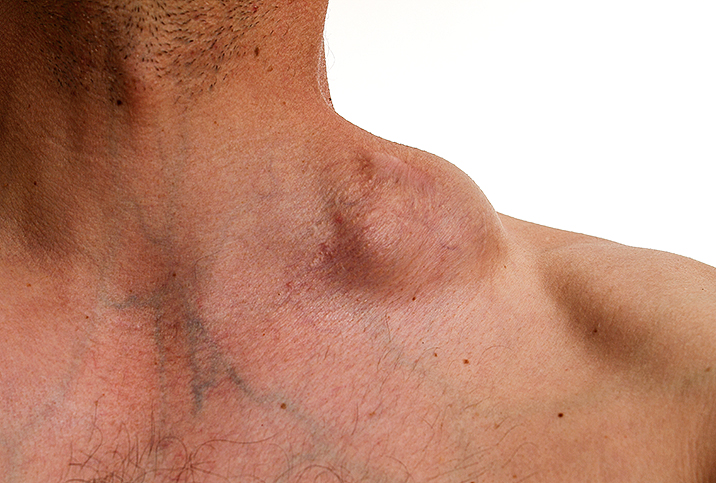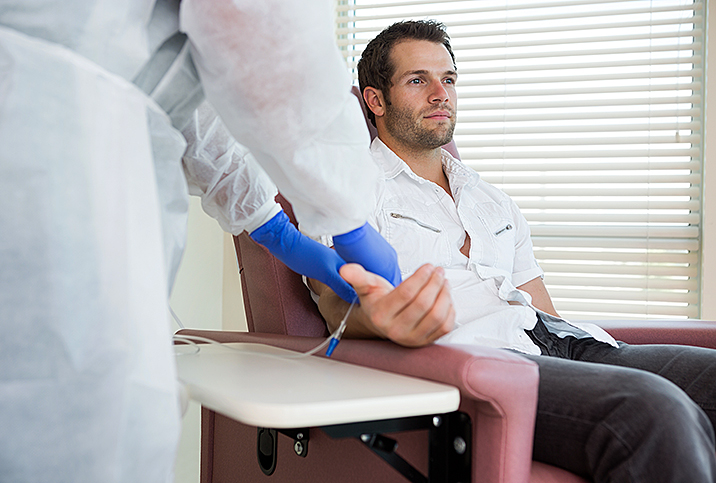What to Know About Non-Hodgkin's Lymphoma

Non-Hodgkin's lymphoma (NHL) is a diverse group of blood cancers that typically develop in the lymphatic tissue, which is part of the body's immune system. NHL can begin anywhere in the body where lymph tissue is found.
One of the most common early signs of non-Hodgkin's lymphoma is painless swelling of a lymph node, of which there are approximately 600 in the body.
"Patients can present with a spectrum of different symptoms, from having no symptoms at all—when it comes to the slow-growing lymphomas—to having constitutional symptoms," said Marc Braunstein, M.D., a hematologist-oncologist at NYU Langone's Perlmutter Cancer Center.
Possible symptoms include persistent fevers, drenching night sweats, unexplained weight loss, chest pain and trouble breathing.
"We're talking about nagging, persistent symptoms that are unusual and not going away," Braunstein explained, adding that a patient can have different symptoms pending the location of the enlarged lymph nodes that characterizes the lymphoma. For instance, an enlarged lymph node in the neck could cause a change in the voice and pain in the abdomen or the groin.
"Lymphoma can also occur in organs outside of the lymph nodes—for example, the bone. That can cause pain or fracture in a bone and could lead to symptoms as well," he said.
One of the most common cancers, non-Hodgkin's lymphoma accounts for approximately 4 percent of all cancers in the United States, according to The American Cancer Society. The association estimates that nearly 82,000 Americans will have been diagnosed with NHL in 2021, and about 20,720 people will die from the disease. The overall risk that a male will develop non-Hodgkin's lymphoma in their lifetime is about 1 in 41; for a female, about 1 in 52.
What's the difference between Hodgkin's and non-Hodgkin's?
"Lymphoma is divided into Hodgkin's lymphoma and non-Hodgkin's lymphoma," Braunstein explained. "Hodgkin's lymphoma, which is less common than NHL, behaves differently and is treated distinctly from all the other types of NHL.
"The difference is essentially a pathological difference," he added. "When you get the lymph node biopsy, the cells appear different, and the pathologist will be able to characterize Hodgkin's lymphoma as having a completely distinct morphology and different pattern under the microscope."
Hodgkin's has a specific type of abnormal cell known as a Reed-Sternberg cell, which is not present in non-Hodgkin's.
"Both are related to a type of lymphocyte or immune cell, called a B cell, though there are other types, such as T-cell lymphomas, which are less common," Braunstein said. "The reason we distinguish between the two is that they're treated distinctly and display different behaviors. While both have potentially curable subtypes, the treatment is very different."
The diagnosis
In addition to medical history and a physical exam, Braunstein noted that imaging tests and bloodwork are important diagnostic tools.
"The bloodwork would be looking for any changes in blood count that might suggest that there's the involvement of the lymphoma in the lymph nodes or in the blood marrow, which is the part of the body where the blood cells are made, and lymphoma can occur in that organ," he explained. "We may be looking for certain markers in the blood that are not really specific for lymphoma, but do change or become elevated when someone has lymphoma."
Lactate dehydrogenase, or LDH, is a marker of cell activity and can be elevated in lymphoma cases. Liver and kidney function will also be examined to ensure no other organ dysfunction could be related to the lymphoma.
The overall risk that a male will develop non-Hodgkin's lymphoma in their lifetime is about 1 in 41; for a female, about 1 in 52.
Imaging tests typically include either the CT scan or the PET scan, which is a type of CT scan that also includes a dye that will show more metabolic activity in areas where lymphoma is present.
"That scan will show the extent of the lymphoma and also help guide where we can potentially put a needle in to get a biopsy, which is essentially what makes the exact diagnosis to pinpoint what type of non-Hodgkin's lymphoma the patient has," Braunstein said.
A bone marrow biopsy may be done to check for lymphoma cells in the bone marrow.
Sexual side effects
Ana Victoria Portillo, MSSW, LMSW, an information specialist at The Leukemia & Lymphoma Society, noted that while non-Hodgkin's lymphoma survivors are living longer, fuller lives, concern about long-term sexual side effects remain.
"Although sexual changes are common with aging in the general population, some studies have reported 25 percent to 30 percent sexual dysfunction or sexual dissatisfaction in long-term NHL survivors that can be attributed to their cancer treatment history," Portillo explained.
She noted that several studies indicate an association between body image and sexual dysfunction in cancer survivors. Gender and age may be contributing factors.
"For example, sexual changes in NHL survivors have been reported in 35 percent of women and 15 percent of men," Portillo added.
In some instances, protecting women against cancer-treatment-related infertility has proven more challenging than in men. Fertility preservation in men is simpler, and sperm storage has become more widely available. However, for women diagnosed with aggressive non-Hodgkin's lymphoma, delaying lifesaving treatment may not be an option, and the fertility preservation process for women can be lengthy.
"NHL treatment may also lead to the absence of menstruation, and, for some, lead to premature menopause," Portillo said.
Treatment for NHL
For non-Hodgkin's lymphoma, treatment generally involves a combination of immunotherapy with antibodies, which target B-cells and chemotherapy. This works to break down those more rapidly dividing lymphoma cells. The regimen is typically given approximately every three weeks for six cycles.
"Up to 60 percent of patients can be cured and put into remission with that therapy alone," Braunstein said.
On the other hand, some patients with newly diagnosed NHL may not require treatment. These are patients with the more indolent, or slow-growing, types. The number of treatments for both non-Hodgkin's and Hodgkin's lymphoma is expanding quickly.
"We have a lot of treatments in our arsenal to tackle patients who don't respond to the initial treatment," Braunstein added.
Braunstein noted that patients with molecular lymphoma—which are marginal zone lymphomas—need treatment if the lymph nodes are larger than a certain size. Patients with diffuse large B-cell lymphoma, the most common type of NHL, need treatment, too, because the likelihood of disease-causing symptoms is very high, and could become life-threatening.
The five-year survival rate for non-Hodgkin's lymphoma is about 73 percent.
"We're definitely pushing the goalposts further in terms of prolonging survival," Braunstein said.


















